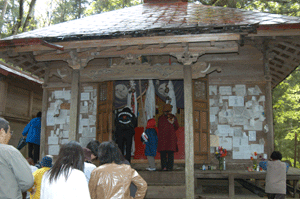寺下観音
 奥州南部糠部三十三ヶ所巡礼一番札所である寺下観音。観音堂の中には、千数百年前に行基(ぎょうき)という高僧が伝えたという観音像が安置されています。境内には西国三十三ヶ所巡礼の観音様が祭られており、ここでお参りすればそのご利益も受けられると言われています。
奥州南部糠部三十三ヶ所巡礼一番札所である寺下観音。観音堂の中には、千数百年前に行基(ぎょうき)という高僧が伝えたという観音像が安置されています。境内には西国三十三ヶ所巡礼の観音様が祭られており、ここでお参りすればそのご利益も受けられると言われています。
また観音堂のほかに潮山神社があり、神仏混交の地として古くから霊地として近隣の人々から信仰されてきました。
毎年5月第3土日に開催される例祭には、県内外から大勢の人が訪れます。
Terashita Kannon
Terashita Kannon Temple was built about 1,300 years ago during the Kamakura period (1185–1333). Dedicated to the Buddhist deity Kannon, the bodhisattva of compassion, it is the first stop on a 33-temple pilgrimage route across Aomori and Iwate prefectures.
A torii gate stands at the entrance to the extensive grounds, which also include Ushioyama Jinja Shrine. Until the Meiji era (1868–1912) it was common for Buddhist temples and Shinto shrines to share the same precinct. However, after the Meiji government enacted a law enforcing separation of the two traditions, the Kannon statue at Terashita was moved to a temple in the neighboring town of Hachinohe. Eventually it was returned, and now rests in the Kannondo, a hall dedicated to Kannon.
The 33 statues surrounding the Kannondo are representations of other temples in western Japan dedicated to Kannon. Pilgrims from Terashita Kannon would make the rounds of these temples and return with soil which they buried under the statue corresponding to each temple. This way, believers unable to make the long journey could at least visit the distant temples in spirit.
The stairs from the Kannondo lead up to a bell tower that houses a bell commissioned by the lord of Hachinohe in 1720. The bell was removed by the military during World War II, when metal collected from around the country was being smelted to manufacture weapons. Fortunately, the war ended just as the bell was on its way to be melted down, and it was safely returned to the temple. Local legend has it that those who place their heads inside the bell while it is being rung will gain wisdom. Though this may seem like a risky practice, the actual sound inside the bell is surprisingly subdued and pleasant.
Terashita Kannon hosts its annual festival the third weekend of May, when many people visit to pray at the Temple.
<简体字>
寺下观音
寺下观音建于大约1300年前的镰仓时代(1185-1333),寺内供奉佛教的大慈大悲观音菩萨。这里是跨越青森和岩手两县的朝圣之旅——“奥州南部糠部三十三观音巡礼”的首站。
走过一道鸟居便来到规模宏大的寺院,寺内还有一座潮山神社。明治时代(1868-1912)以前,佛教寺庙和神道教神社共用土地是普遍现象。后来明治政府颁布神佛分离的法令,寺下的观音像曾被移至旁边八户市的一座寺庙。不过雕像最终还是被请回,现安放在观音堂内。
观音堂四周还有33尊观音像,代表着“西国三十三所”※的观音寺。以前,从寺下观音出发的朝圣者每到其中一处灵场巡礼时,会从那里带走一捧土,返回寺下观音后,把它们分别埋在代表每处灵场的观音像底下。这样做至少可以让无法长途跋涉的信徒们能以遥拜表达心意。
从观音堂拾级而上可到钟楼,里面有一口八户藩领主于1720年命人铸造的梵钟。二战期间,军方在全国搜获金属熔炼后制造武器,这口钟也被搬走。所幸在其即将被熔化的时候,战争结束了,梵钟最终完璧无损地回到了寺中。本地传说钟声鸣响时,将头伸进钟里能增长智慧。这个说法听起来危险,但其实当钟声响起时,钟内的声音却意外地柔和悦耳。
每年5月的第3个周六、周日是寺下观音的“例大祭”。期间寺内钟声悠扬,会有众多的参拜者前来祈求无病消灾、阖家平安、五谷丰收以及海上安全,热闹非凡。
※西国三十三所:观音有三十三相,奈良时代的德道上人拟定33所观音寺作为巡礼灵场,因所在地和歌山县、大阪府、奈良县、京都府、滋贺县、兵库县以及岐阜县集中在本州岛西部,故称“西国”。
<繁体字>
寺下觀音
寺下觀音建於大約1300年前的鐮倉時代(1185-1333),寺內供奉佛教的大慈大悲觀音菩薩。這裡是跨越青森和岩手兩縣的朝聖之旅——「奧州南部糠部三十三觀音巡禮」首站。
穿越一道鳥居便來到規模宏大的寺院,寺內還有一座潮山神社。明治時代(1868-1912)以前,佛教寺廟和神道教神社共用土地是普遍現象。後來明治政府頒佈神佛分離的法令,寺下的觀音像曾被暫時移至鄰近八戶市的寺廟。不過雕像最終被請回,現安放在觀音堂內。
觀音堂四周還有33尊觀音像,代表著「西國三十三所」※的觀音寺。以前,從寺下觀音出發的朝聖者每到其中一處靈場巡禮時,會從當地帶走一捧土,返回寺下觀音後,把它們分別埋在代表每處靈場的觀音像底下,讓無法長途跋涉的信徒們能以遙拜表達心意。
從觀音堂拾級而上到達鐘樓,樓裡有一口梵鐘是八戶藩領主於1720年命人鑄造的。二戰期間,軍方在全國搜獲金屬以熔煉製造武器,當時這口鐘也被搬走。所幸在其即將被熔化的時候,戰爭結束了,因此該鐘最終完璧無損地回到了寺中。本地傳說鐘聲鳴響時,將頭伸進鐘裡能增長智慧。這個說法聽起來危險,但其實當鐘聲響起時,鐘內的聲音卻意外地柔和悅耳。
每年5月的第3個週六、週日是寺下觀音的「例大祭」。期間寺內鐘聲悠揚,會有眾多的參拜者前來祈求無病消災、闔家平安、五穀豐收以及航海平安,熱鬧非凡。
※西國三十三所:觀音有三十三座化身,奈良時代的德道上人擬定33所觀音寺作為巡禮靈場,因所在地和歌山縣、大阪府、奈良縣、京都府、滋賀縣、兵庫縣以及岐阜縣集中在本州西部,故稱「西國」。

地域観光資源の多言語解説整備支援事業



